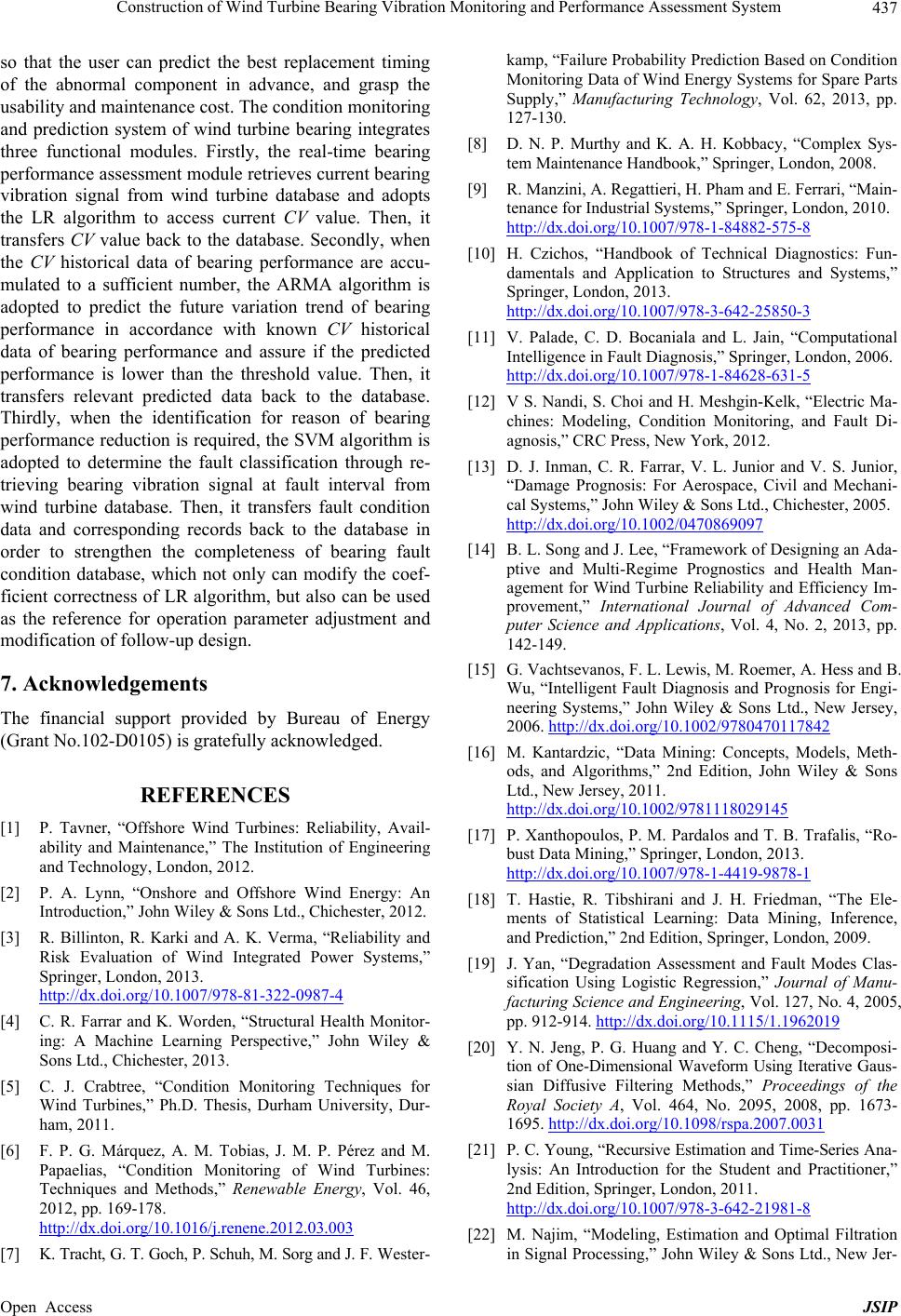
Construction of Wind Turbine Bearing Vibration Monitoring and Performance Assessment System 437
so that the user can predict the best replacement timing
of the abnormal component in advance, and grasp the
usability and maintenance cost. The cond ition monitoring
and prediction system of wind turbine bearing integrates
three functional modules. Firstly, the real-time bearing
performance assessment module retrieves current bearing
vibration signal from wind turbine database and adopts
the LR algorithm to access current CV value. Then, it
transfers CV value back to the database. Secondly, when
the CV historical data of bearing performance are accu-
mulated to a sufficient number, the ARMA algorithm is
adopted to predict the future variation trend of bearing
performance in accordance with known CV historical
data of bearing performance and assure if the predicted
performance is lower than the threshold value. Then, it
transfers relevant predicted data back to the database.
Thirdly, when the identification for reason of bearing
performance redu ction is required, the SVM algorithm is
adopted to determine the fault classification through re-
trieving bearing vibration signal at fault interval from
wind turbine database. Then, it transfers fault condition
data and corresponding records back to the database in
order to strengthen the completeness of bearing fault
condition database, which not only can modify the coef-
ficient correctness of LR algorithm, but also can be used
as the reference for operation parameter adjustment and
modification of follow-up design.
7. Acknowledgements
The financial support provided by Bureau of Energy
(Grant No.102 -D 01 0 5) is gratefully acknowledged.
REFERENCES
[1] P. Tavner, “Offshore Wind Turbines: Reliability, Avail-
ability and Maintenance,” The Institution of Engineering
and Technology, London, 2012.
[2] P. A. Lynn, “Onshore and Offshore Wind Energy: An
Introduction,” John Wiley & Sons Ltd., Chichester, 2012.
[3] R. Billinton, R. Karki and A. K. Verma, “Reliability and
Risk Evaluation of Wind Integrated Power Systems,”
Springer, London, 2013.
http://dx.doi.org/10.1007/978-81-322-0987-4
[4] C. R. Farrar and K. Worden, “Structural Health Monitor-
ing: A Machine Learning Perspective,” John Wiley &
Sons Ltd., Chichester, 2013.
[5] C. J. Crabtree, “Condition Monitoring Techniques for
Wind Turbines,” Ph.D. Thesis, Durham University, Dur-
ham, 2011.
[6] F. P. G. Márquez, A. M. Tobias, J. M. P. Pérez and M.
Papaelias, “Condition Monitoring of Wind Turbines:
Techniques and Methods,” Renewable Energy, Vol. 46,
2012, pp. 169-178.
http://dx.doi.org/10.1016/j.renene.2012.03.003
[7] K. Tracht, G. T. Goch, P. Schu h, M. Sor g and J. F. W e s t e r-
kamp, “Failure Probability Prediction Based on Condition
Monitoring Data of Wind Energy Systems for Spare Parts
Supply,” Manufacturing Technology, Vol. 62, 2013, pp.
127-130.
[8] D. N. P. Murthy and K. A. H. Kobbacy, “Complex Sys-
tem Maintenance Handbook,” Springer, London, 2008.
[9] R. Manzini, A. Regattieri, H. Pham and E. Ferrari, “Main-
tenance for Industrial Systems,” Springer, London, 2010.
http://dx.doi.org/10.1007/978-1-84882-575-8
[10] H. Czichos, “Handbook of Technical Diagnostics: Fun-
damentals and Application to Structures and Systems,”
Springer, London, 2013.
http://dx.doi.org/10.1007/978-3-642-25850-3
[11] V. Palade, C. D. Bocaniala and L. Jain, “Computational
Intelligence in Fault Diagnosis,” Springer, London, 2006 .
http://dx.doi.org/10.1007/978-1-84628-631-5
[12] V S. Nandi, S. Choi and H. Meshgin-Kelk, “Electric Ma-
chines: Modeling, Condition Monitoring, and Fault Di-
agnosis,” CRC Press, New York, 2012.
[13] D. J. Inman, C. R. Farrar, V. L. Junior and V. S. Junior,
“Damage Prognosis: For Aerospace, Civil and Mechani-
cal Systems,” John Wiley & Sons Ltd., Chichester, 2005.
http://dx.doi.org/10.1002/0470869097
[14] B. L. Song and J. Lee, “Framework of Designing an Ada-
ptive and Multi-Regime Prognostics and Health Man-
agement for Wind Turbine Reliability and Efficiency Im-
provement,” International Journal of Advanced Com-
puter Science and Applications, Vol. 4, No. 2, 2013, pp.
142-149.
[15] G. Vachtsevanos, F. L. Lewis, M. Roemer, A. Hess and B.
Wu, “Intelligent Fault Diagnosis and Prognosis for Engi-
neering Systems,” John Wiley & Sons Ltd., New Jersey,
2006. http://dx.doi.org/10.1002/9780470117842
[16] M. Kantardzic, “Data Mining: Concepts, Models, Meth-
ods, and Algorithms,” 2nd Edition, John Wiley & Sons
Ltd., New Jersey, 2011.
http://dx.doi.org/10.1002/9781118029145
[17] P. Xanthopoulos, P. M. Pardalos and T. B. Trafalis, “Ro-
bust Data Mining,” Springer, London, 2013.
http://dx.doi.org/10.1007/978-1-4419-9878-1
[18] T. Hastie, R. Tibshirani and J. H. Friedman, “The Ele-
ments of Statistical Learning: Data Mining, Inference,
and Prediction,” 2nd Edition, Springer, London, 2009.
[19] J. Yan, “Degradation Assessment and Fault Modes Clas-
sification Using Logistic Regression,” Journal of Manu-
facturing Science and Engineering, Vol. 127, No. 4, 2005,
pp. 912-914. http://dx.doi.org/10.1115/1.1962019
[20] Y. N. Jeng, P. G. Huang and Y. C. Cheng, “Decomposi-
tion of One-Dimensional Waveform Using Iterative Gaus-
sian Diffusive Filtering Methods,” Proceedings of the
Royal Society A, Vol. 464, No. 2095, 2008, pp. 1673-
1695. http://dx.doi.org/10.1098/rspa.2007.0031
[21] P. C. Young, “Recursive Estimation and Ti me-Series Ana -
lysis: An Introduction for the Student and Practitioner,”
2nd Edition, Springer, London, 2011.
http://dx.doi.org/10.1007/978-3-642-21981-8
[22] M. Najim, “Modeling, Estimation and Optimal Filtration
in Signal Processing,” John Wiley & Sons Ltd., New Jer-
Open Access JSIP